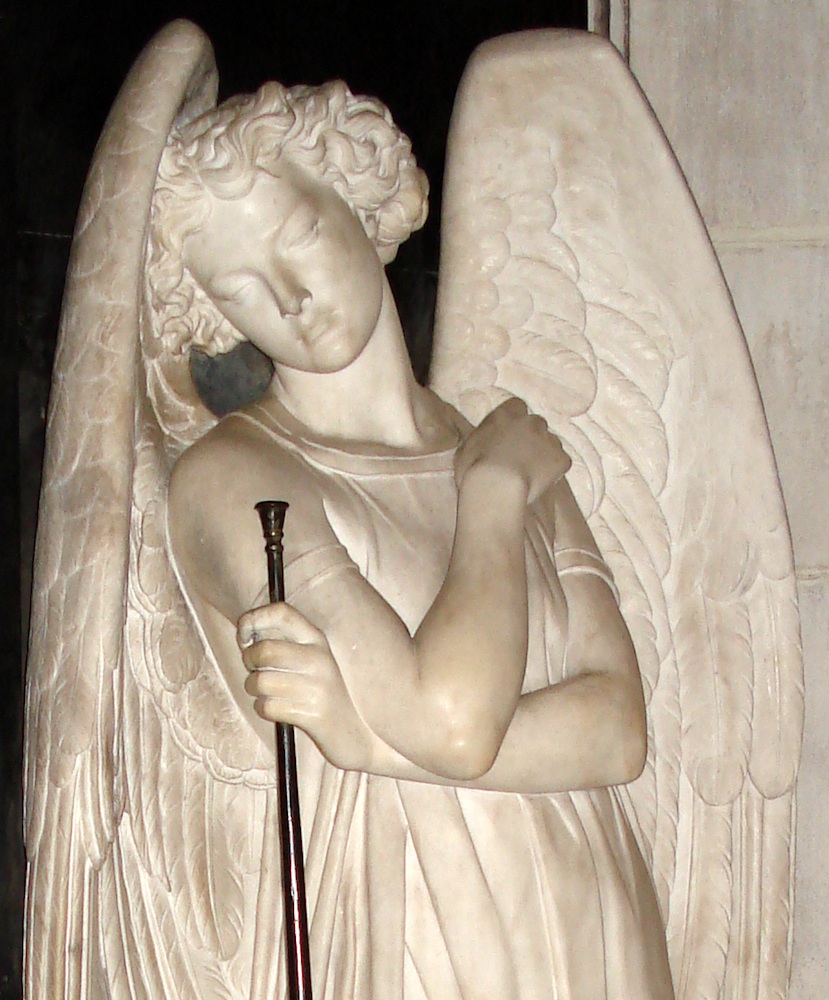
Central part of the monument. [Click on all the images here to enlarge them.]
Monument to the Viscounts Melbourne, by Baron Carlo Marochetti (1805-1867). St Paul's Cathedral, London. The two Viscounts were Queen Victoria's first prime minister, William, Viscount Melbourne (1779-1848), and his younger brother Frederick (1782-1853), a diplomat, who duly became the third Viscount Melbourne in 1848. The marble, bronze and gilt bronze monument takes the form of two larger-than-life white marble figures of angels, at either side of a black marble and gilt bronze door over which is inscribed, from the Easter Even Collect, "Through the gate of death we pass to our joyful resurrection." The Viscounts are separately identified on the elaborate panels on each half of the door, to which crests, the family motto "Virtute et Fide" ("By Virtue and Faith") and the following poignant biblical texts are added: "Until the day break and the shadows flee away" (from the Song of Solomon 2, 17) and "They that dwell under his shadow shall return" (from Hosea 14, 7). This unusual monument stands in the first recess of the north aisle of the nave.


Closer views of the two angels either side of the door. The angel on the left carries a bronze sword, and the one on the right carries a bronze trumpet, not yet ready to be blown. Wings folded and eyes shut in gentle slumber, both angels seem to be waiting patiently for the promised resurrection.
The monument has fairly been described as an "ambitious" one. The Dean of St Paul's at the time, Dean Milman, said later that he had no hesitation about admitting the Viscounts "into our Valhalla" (491), but there does seem to have been some question about whether "the gay Melbourne" (i.e., the Prime Minister), deserved it (Thornbury). Certainly, Lord Melbourne's Times obituary seemed to struggle to be fair to him, but could only conclude that "there have been many worse Ministers and many worse men than the second Viscount Melbourne" (5). Lytton Strachey's long analysis of the ex-prime minister's complex and fascinating character, and of his relationship with the young queen, on the whole does him more justice. Strachey describes both his decline in influence after the queen's marriage, and his physical and mental decline, with some sympathy, and concludes that with his death died too "the last vestige of the eighteenth century.... cynicism and subtlety were shrivelled into powder, and duty, industry, morality and domesticity triumphed over them" (117). The new standards sound more virtuous but duller. Another question was about the suitability of the text over the door: "The complete darkness with nothing beyond is more appropriate to the Premier's religious views as stated in the Greville Memoirs," wrote the Reverend Arthur Dimock disapprovingly at the turn of the century (124). He probably had in mind a reference in Charles Greville's memoirs to Melbourne's "perfect conviction of unbelief" (323). As for the third Viscount, his own death notice in the Times was very brief, even though he had held diplomatic posts in Bavaria and Spain, and served as an ambassador in Lisbon and Vienna (see Sinclair 261). The notice ended with the information that, since he left no family, the title was now extinct.

Whole monument, showing entablature.
At any rate, whether or not Melbourne and his brother deserved such a distinctive and lavish monument, the work itself is impressive, both thoughtfully conceived and beautifully executed. Dean Milman says Marochetti was "permitted ... full freedom for his powers of invention and execution here" (490), so the design was entirely his own. His angels repose gracefully in their simple gowns, their folded arms beautifully instinct with warm life. Of necessity, they are relaxed and languid, but there is a hint in the group as a whole, with its mixed materials, of the realism of the later New Sculpture. Moreover, since the monument lacks any likenesses of the Viscounts themselves, it has a wider, more universal resonance.
Photographs © Caroline Hedengren-Dillon, reproduced here with her kind permission, and with thanks to the Dean and Chapter of St Paul’s Cathedral. text by Jacqueline Banerjee. You may use these images without prior permission for any scholarly or educational purpose as long as you (1) credit the photographer and (2) link your document to this URL in a web document or cite the Victorian Web in a print one.]
Related Material
Bibliography
"Death of Viscount Melbourne." The Times. 25 November 1848: 5. Times Digital Archive. 16 August 2014.
"Death of Viscount Melbourne." The Times. 31 January 1853: 4. Times Digital Archive. 16 August 2014.
Dimock, Arthur, Rev. The Cathedral Church of Saint Paul: An Account of the Old and New Buildings with a Short Historical Sketch. London: George Bell & Sons, 1901. Internet Archive. Uploaded” by the University of Wisconsin — Madison. Web. 16 August 2014.
Greville, Charles. The Greville Memoirs A Journal of the Reigns of King George IV and King William IV. Vol. III Internet Archive (from Project Gutenberg). Web. 16 August 2014.
Milman, Henry Hart. Annals of St Paul's Cathedral. London: John Murray, 1868. Google Books. Free Ebook. Web. 16 August 2014.
Object Collection No. 2474. St. Paul's Cathedral. Web. 16 August 2014.
Sinclair, William Macdonald.
Strachey, Lytton. Queen Victoria: A Life. London: Tauris Parke Paperbacks, 2012.
Thornbury, Walter. "St Paul's: The New Church." Old and New London: Volume 1. London: , 1878: 249-262. British History Online. Web. 16 August 2014.